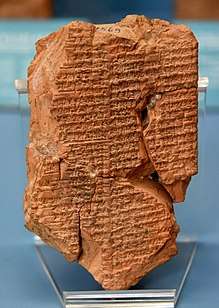Enkimdu
Enkimdu is the Sumerian god of farming, in charge of canals and ditches, a task assigned to him by the water god Enki during his organization of the world.

| Part of a series on |
| Ancient Mesopotamian religion |
|---|
 Chaos Monster and Sun God |
|
Seven gods who decree
|
|
Other major deities |
|
Demigods and heroes
|
| Related topics |
Enkimdu is featured prominently in the myth "Inanna Prefers the Farmer," in which both he and the god Dumuzi are attempting to win the hand of the goddess Inanna. While Inanna is quite infatuated with the down-to-earth farmer, her brother Utu/Shamash attempts to convince her to marry Dumuzi instead. Both Dumuzi and Enkimdu face off in an argument over who will win Inanna. While Dumuzi is aggressive in his arguments, attempting to prove that he is far better, Enkimdu is more docile and peaceful, attempting to resolve the situation diplomatically.
The clay tablet on which the myth is written has been damaged over the passage of time, but from later myths such as "Dumuzi and Inanna" and "Inanna's Descent into the Underworld," it is clear that Inanna eventually selects Dumuzi as her spouse.
Enkimdu in modern usage
ENKIMDU is a name of an agent-based modeling platform used to study socio-ecological interactions in ancient Mesopotamia[1][2][3] and villages in modern Thailand, "implemented entirely in standard Java".[4]
Notes
- Altaweel, Mark (2008). "Investigating agricultural sustainability and strategies in northern Mesopotamia: results produced using a socio-ecological modeling approach" (PDF). Journal of Archaeological Science. 35: 821–835. doi:10.1016/j.jas.2007.06.012. Retrieved 4 September 2017 – via The University of Edinburgh – School of Geosciences.
- Altaweel, Mark (2006). "Addressing the Structures and Dynamics of Modeled Human Ecologies" (PDF). CAA Proceedings Online. Retrieved 4 September 2017.
- Christiansen, John; Altawee, Mark (2005). "Agent-Based Holistic Simulations of Bronze Age Mesopotamian Settlement Systems" (PDF). CAA Proceedings Online. Retrieved 4 September 2017.
- Christiansen, John H.; Altaweel, Mark R. (2006) [Composed 2005]. "Understanding Ancient Societies: A New Approach Using Agent-Based Holistic Modeling" (PDF). Structure and Dynamics: eJournal of Anthropological and Related Sciences. 1 (2). eISSN 1554-3374. Archived from the original on 2005.